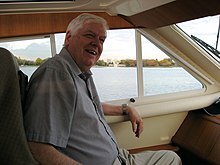Hamilton Othanel Smith
Hamilton Othanel Smith (born August 23, 1931 in New York , USA ) is an American biochemist , molecular geneticist and Nobel Prize winner for medicine .
Life
Hamilton Othanel Smith was born the son of a teacher and a university professor in New York , where his father was at the time an assistant professor at Columbia University . Over the next several years, the family commuted between New York and the University of Florida in Gainesville as part of his father's academic training . In 1937 the family moved to Champaign-Urbana, Illinois, where his father worked at the University of Illinois .
Hamilton O. Smith began studying mathematics at the University of Illinois at Urbana-Champaign , then moved to the University of California, Berkeley in 1950 and attended courses there for the first time in areas that interested him more than mathematics: cell physiology , biochemistry and Biology . He finished his math studies in 1952 with a bachelor's degree and moved to Johns Hopkins University ( Baltimore ) and began studying medicine. In 1956 he made his doctorate there and then went to the Barnes Hospital in St. Louis as a " doctor in internship " .
In 1957 he was called up as part of the Doctor's Draft program during the Korean War and served two years in the Navy in San Diego . There he dealt more intensively with books on genetics for the first time . In 1959 he moved to the Henry Ford Hospital in Detroit for further medical training. In 1962 he went to the University of Michigan as a postdoctoral fellow and did research in the Department of Human Genetics . His main focus was salmonella bacteriophages .
In 1967 he returned to Johns Hopkins University as an assistant professor of microbiology . His main areas of study were: restriction and modification enzymes, the enzymology of genetic recombination , bacterial transformation (genetics) and gene regulation in prokaryotes and eukaryotes .
In 1968 he and Kent W. Wilcox discovered the first type II restriction enzyme , now known as HindII . In 1975 he received a Guggenheim scholarship , which he spent at the University of Zurich . There he did research together with Max Birnstiel of histones .
In 1978, together with Werner Arber and Daniel Nathans, he received the Nobel Prize in Physiology or Medicine “for their discovery of restriction enzymes and the use of these enzymes in molecular genetics ”. In 1980 he was accepted into the American Academy of Arts and Sciences and the National Academy of Sciences .
Today he conducts research at the J. Craig Venter Institute in La Jolla, founded by Craig Venter .
Web links
- Information from the Nobel Foundation on the 1978 award to Hamilton O. Smith
- Interview with Hamilton Smith and Richard John Roberts at the Nobel Laureate Meeting in Lindau in 2000
Individual evidence
- ↑ Johann Grolle: The essence of life. in: Der Spiegel, March 26, 2016, p. 106 f.
| personal data | |
|---|---|
| SURNAME | Smith, Hamilton Othanel |
| BRIEF DESCRIPTION | American biochemist |
| DATE OF BIRTH | August 23, 1931 |
| PLACE OF BIRTH | New York , USA |
